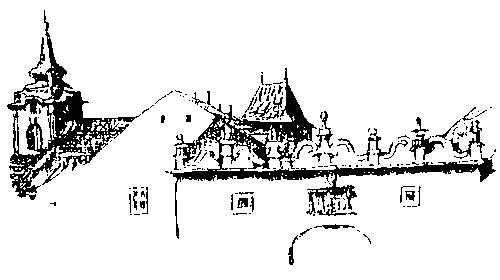A brief history of the town
Český Brod
 Český Brod is an ancient gothic town founded most probably by Prague’s bishop Jan I. in the 12th century on one of the country’s most important provincial paths, called Trstenická, linking the then market settlement of Prague with south-eastern Europe. Jan III of Dražice, the bishop of Prague, made the local market settlement a town – Biskupský Brod (Broda Episcopalis, Bishopford) in the middle of the 13th century. Owing to trading and travelling activities and extensive agriculture in the local vicinity, Biskupský Brod soon became a significant trading centre possessing both a market and guest houses. At the beginning of the 14th century the name of the town was changed to Český Brod (Broda Bohemicalis, Czechford), to be distinguished from the town of Německý Brod (Broda Germanica, Germanford), lying on the same commercial path.
Český Brod is an ancient gothic town founded most probably by Prague’s bishop Jan I. in the 12th century on one of the country’s most important provincial paths, called Trstenická, linking the then market settlement of Prague with south-eastern Europe. Jan III of Dražice, the bishop of Prague, made the local market settlement a town – Biskupský Brod (Broda Episcopalis, Bishopford) in the middle of the 13th century. Owing to trading and travelling activities and extensive agriculture in the local vicinity, Biskupský Brod soon became a significant trading centre possessing both a market and guest houses. At the beginning of the 14th century the name of the town was changed to Český Brod (Broda Bohemicalis, Czechford), to be distinguished from the town of Německý Brod (Broda Germanica, Germanford), lying on the same commercial path.
As early as 1402, Český Brod’s burghers built their town hall in the middle of the square, in accordance with the practice of the time. Following the break-up of the Český Brod archbishopric district and other historical events, the town was occupied by emperor Zikmund. Troops from Prague together with their Hussite allies then conquered the town in 1421 and it was thus temporarily incorporated in the so-called ‘Orphan Town Union’. Not long after the Battle at Lipany, the town representatives concluded an armistice with the baronial league. During negotiations with emperor Zikmund, a guarantee of the revolutionary liberties was achieved and following that, on 4th February 1437, the emperor designated Český Brod as a free royal town. According to current historical opinion, this was a time when the local citizens displayed unity. Their decision launched paving the way towards development and prosperity of their town.
Among the most significant historical sights of the town rank the St. Gothard cathedral, a lone-standing late-gothic belfry as well as the aforementioned old town hall. Still today, under the houses in the historical heart of the town, there are well-preserved ancient gothic vaults and an underground passage system. This system linked the underground areas and doubtlessly was used for defence purposes. Nowadays, it is accessible to the public.
In the heart of the town, we can find The Saint Family, a baroque group of statues by F.M. Brokoff.
Among other monuments worth mentioning belongs a new-renaisance building of the Podlipanské museum by the architect A. Balšánek. There we can see, amongst other exhibits, new expositions on Český Brod’s past, an exposition of the Battle at Lipany, a stately monument of Prokop the Great by the sculptor Karel Opatrný and the Sokolovna assembly building designed by the professor Jan Koula. Though no longer fully intact, the medieval stone walls are another noted monument. Unfortunately, the entrance gates were pulled down long ago. The remains of the ancient fortification are gradually being conserved.
Today’s Český Brod, of which parts are the former villages of Štolmíř and Liblice, is a quiet town with a small manufacturing base and is home to roughly seven thousand inhabitants. It is the second largest municipality in the Kolín district. Thanks to the railway corridor, a great number of the inhabitants commute to work to either Prague or Kolín.
Český Brod is a place worth dropping by in and is a place where you can set out from on trips to the interesting surroundings – the Lipany battlefield, the Dolánky natural reserve, the town of Kostelec nad Černými Lesy, the Klepec hill national reserve, the Tismice basilica, the Tuchoraz citadel, etc. Český Brod is a place rightly deserving your attention.

